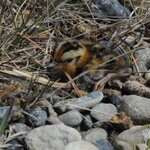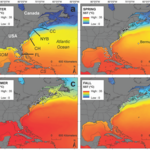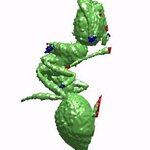Ecology & Zoology

For people from eastern states like New York or Boston, California is a dream. People feel like they could just take over and declare themselves King and no one would try to stop them because it would hurt their feelings. It's like Canada, except the women are all in Daisy Duke shorts and bikini tops.
But that passive demeanor isn't good when nature wants to kill you. And she does. Watersnakes, commonly seen in the lakes, rivers and streams of the eastern United States, are invading California waterways and may wipe out native species, according to a new study.
While scientists do not…

Field surveys are so 20th century. Satellites are the wave of the future when studying remote penguin populations. Like with space travel, we may someday wonder why we wouldn't send robots or satellites to do a man's work.
Penguins residing on Antarctica's ice sheets must face moving, breaking, and shifting ice. Accurate monitoring of population trends is critical to understanding the ongoing rapid changes in Antarctic ecosystems. However, the remoteness and logistical complexity of operating in Antarctica, especially during winter, can make such an assessment difficult.
Satellite imaging is…

A new study finds that migratory birds that breed in Arctic Alaska are initiating nests earlier in the spring, and that snow melt occurring earlier in the season is a big reason for it.
The researchers looked in nearly 2,500 nests of four shorebird species: semi-palmated sandpiper, red phalarope, red-necked phalarope, and pectoral sandpiper, and one songbird, the lapland longspur, and recorded when the first eggs were laid in each nest. The research occurred across four sites that ranged from the oilfields of Prudhoe Bay to the remote National Petroleum Reserve of western Arctic Alaska…

Around 165 million years ago, a bizarre parasite lived in the freshwater lakes of present-day Inner Mongolia - fly larva with a thorax formed entirely like a sucking plate.
With this odd thorax, the animal could adhere to salamanders and suck their blood with its mouthparts formed like a sting. To date no insect is known that is equipped with a similar specialised design.
Named
Qiyia jurassica, the parasite, an elongate fly larva around two centimeters long, had undergone extreme changes over the course of evolution: The head is tiny in comparison to the body, tube-shaped with piercer-…

Spiders are traditionally viewed as predators of insects but zoologists have published a study that finds spiders all over the world also prey on fish.
That spiders are not exclusively insectivorous and larger-sized species supplement their diet by occasionally catching small fish is somewhat new.
According to their systematic review, spiders from as many as five families have been observed predating on small fish in the wild and three more families contain species that catch fish under laboratory conditions. These so called semi-aquatic spiders typically dwell at the fringes of…

Honeycomb of European honey bees (Apis mellifera) with eggs and larvae. (Photo credit: Wikipedia)
It’s time once again for everyone’s favorite game show: Environmental Whack-a-Mole!
What Black and White, Manichaean Green scare do we have for scientific experts to bat down with nuanced arguments today, Johnny?
Johnny: “This time It’s Colony Collapse Disorder (CCD) that’s in the news once again. Many greens want to ban a particular class of synthetic pesticide they say leads to CCD. CCD is a mysterious loss of most or all worker bees from the hive of the European honey bee (Apis mellifera),…

Throughout Earth's geological history, there have been numerous warming and cooling phases. The last Ice Age only ended 11-12,000 years ago
The Antarctic Peninsula, the northern most region of Antarctica, is experiencing some dramatic changes, including population declines of some penguin species, but this is not the first time that region has felt the effects of climate warming.
How did penguins respond to the melting of snow and ice cover 11,000 years ago at the end of the last Ice Age?
Genetics can tell us. Tracing modern penguin populations back to their early ancestors from the last Ice…

White sharks
(Carcharodon carcharias)
are among the largest, most widespread apex predators in the ocean so there have been concerns about their vulnerability. The most comprehensive study undertaken on seasonal distribution patterns and historic trends in abundance of white sharks in the western North Atlantic Ocean used records compiled over more than 200 years finds that white sharks are a conservation win.
Scientists from NOAA Fisheries and colleagues added recent grey literature - unpublished, non-peer reviewed data - to previously published data to create a broader picture of 649…

Three years ago, Georgia Institute of Technology researchers took a close look at a connectivity phenomenon - how fire ants work together to build waterproof rafts to stay alive.
After examining the edges and tops of rafts, they discovered that ants grip each other with their mandibles and legs at a force of 400 times their body weight. Next they did what anyone would do.
They froze them.
A miniature CT scan machine helped them to look at the strongest part of the structure – the inside – to discover how opaque ants connect, arrange and orient themselves with each other.
"Now we…
People may associate the concept of the chastity belt with medieval Europe but other parts of the animal kingdom used them long before that.
Male dwarf spiders, for instance, have evolved a mechanical safeguard to ensure their paternity - mating plugs to block off the genital tract of the female they have just mated with. The larger and older the plug, the better the chances are that other males will not make deposits in a female's sperm storage organ, too.
Yes, dwarf spider males (Oedothorax retusus) insert mating plugs into the two copulatory ducts of the females they have mated with…